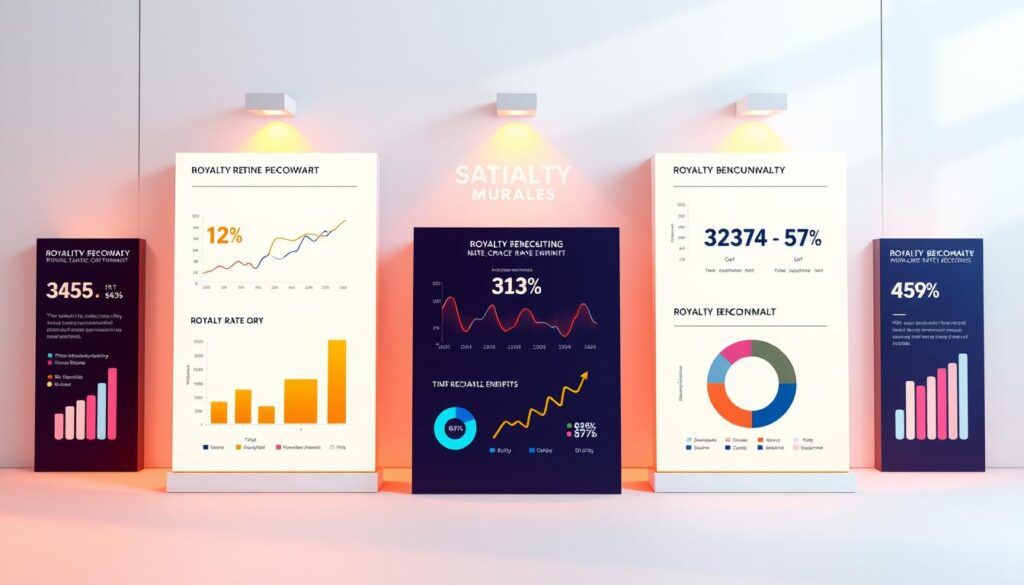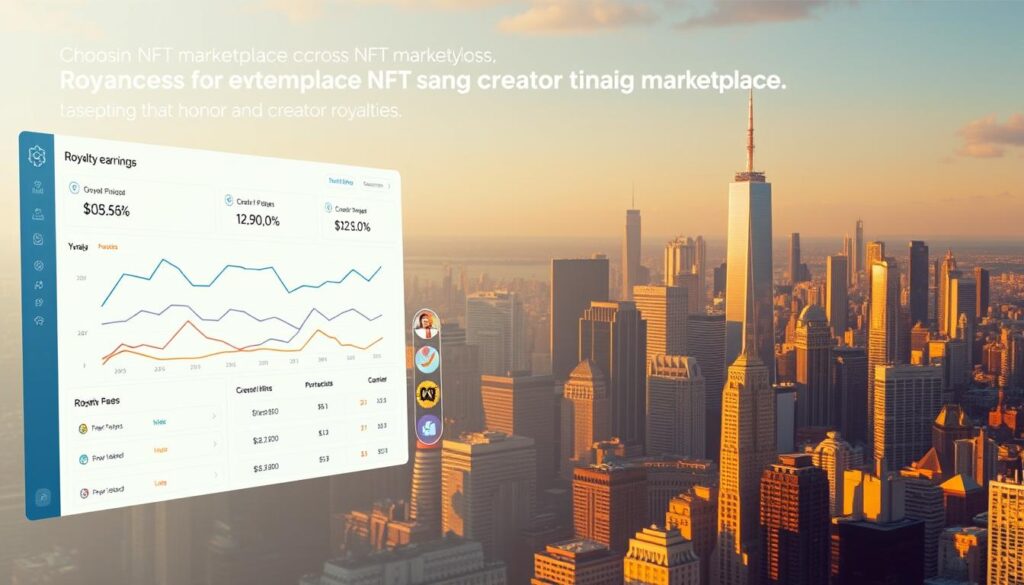Digital ownership has evolved beyond single transactions. A groundbreaking system now lets artists earn recurring revenue when their work trades hands. This model reshapes how value flows between makers and collectors in virtual markets.
Traditional art sales often leave originators with one-time payments. Resales generate profits for buyers, not the original designers. Blockchain technology changes this dynamic through automated, enforceable agreements that redirect a percentage of secondary sales back to the creator.
The market for these digital assets exploded from $15.53 billion in 2021 to a projected $73.90 billion by 2028. This growth creates new financial pathways for makers to benefit from their work’s long-term appreciation. Platforms using smart contracts ensure automatic payments without intermediaries.
This approach addresses historical gaps in creative compensation. Visual producers, musicians, and writers gain ongoing rewards as their creations gain popularity. The system fosters sustainable careers in digital content production while maintaining asset liquidity for collectors.
Key Takeaways
- Recurring revenue models replace single-payment systems in digital markets
- Blockchain enables automatic profit-sharing during resale events
- Market value projections show 376% growth potential by 2028
- Smart contracts eliminate third-party involvement in transactions
- Compensation structures now align with long-term asset value
Understanding NFT Royalties and Digital Creator Earnings
The modern creator economy rewards ongoing contributions through resale mechanisms. When digital pieces transfer ownership, original makers receive automatic percentages – like breadcrumbs marking each resale path. This system transforms how value circulates between originators and collectors.
https://www.youtube.com/watch?v=7nWCazSSeLA
Decoding Resale Compensation Models
Percentage-based payments activate during secondary market transactions. Visual artists might choose 5% per resale, while musicians could opt for 8%. These rates embed directly into blockchain records, ensuring automatic distribution without manual claims.
Traditional compensation models pale in comparison. Physical art sales historically gave painters single payments, even if works later sold for millions. Digital frameworks flip this script, letting makers share in their work’s appreciation.
Sustaining Creative Careers Through Automation
Consistent revenue streams enable three critical advantages:
- Financial predictability for long-term project planning
- Reduced pressure to constantly produce new content
- Compounding value from popular older works
Game developers now fund expansions through character skin resales. Electronic musicians build studios using track royalty accumulations. This structural shift democratizes wealth-building tools previously reserved for industry elites.
The Role of Smart Contracts in Enabling Automatic Royalty Payments
Self-executing code revolutionizes profit-sharing in digital markets. Blockchain-based agreements execute predefined rules when specific conditions meet, transforming how value transfers occur. These protocols act as tireless accountants, tracking ownership changes and distributing funds instantly.

How Smart Contracts Work on the Blockchain
Digital agreements operate through if-then logic coded into assets. When resale happens, blockchain networks detect the transaction. The embedded contract triggers payment calculations, sending percentages directly to designated wallets. This process completes in seconds without manual oversight.
| Feature | Traditional Systems | Smart Contracts |
|---|---|---|
| Payment Speed | Weeks/Months | Instant |
| Intermediaries | 3+ Parties Involved | Direct Transfers |
| Transparency | Limited Visibility | Public Ledger Records |
Advantages of Automated Payments for Creators
Three core benefits emerge from this technology:
- Instant transfers eliminate payment delays
- No collection agencies taking commission fees
- Immutable records prevent contract alterations
Musicians splitting album rights receive exact shares automatically. Visual artists see revenue stream in during midnight resales. This system removes bureaucratic hurdles that once stifled recurring earnings.
NFT royalties and creator earnings passive income opportunities explained

Visual artist Fewocious transformed teenage sketches into seven-figure earnings through strategic digital drops. Their 10% resale clause activates every time works move between crypto wallets, generating continuous revenue since 2021.
Electronic musician 3LAU reimagined music distribution by tokenizing albums. Owners receive exclusive remixes and concert access while the artist earns from secondary sales. This model outperforms streaming platforms’ micropayments by 400x per transaction.
XCOPY’s dystopian animations command six-figure sums at initial sale. The 5% royalty structure ensures compensation every time these glitch-art pieces change hands. Collectors have traded one signature work eight times since 2022, generating $92k in automatic payments.
Successful strategies vary across mediums:
- Visual artists average 5-10% per resale
- Musicians bundle perks with 3-7% rates
- Digital creators reinvest earnings into community projects
These pioneers demonstrate how programmable agreements create lasting value. Their crypto wallets accumulate funds even during market fluctuations, proving resilient income streams exist in Web3 ecosystems.
Setting Fair Royalty Percentages for Sustainable Revenue
Strategic percentage selection determines long-term success in digital markets. Industry benchmarks reveal clear patterns across different content types, helping makers balance earnings with buyer incentives.

Benchmarking Industry Standards and Market Trends
Average rates vary by category. Visual works typically use 5-10% per resale, while gaming assets hover around 2.5-7.5%. Music projects often split the difference with 3-8% structures.
| Category | Average Rate | Key Influencers |
|---|---|---|
| Digital Art | 6.8% | Artist reputation, collection size |
| Music Releases | 4.9% | Track length, exclusivity perks |
| Gaming Items | 5.2% | Utility, rarity tiers |
Balancing Creator Earnings with Buyer Appeal
High percentages discourage resales. Low rates undervalue contributions. Successful strategies consider three factors:
- Secondary market liquidity thresholds
- Competitor rate analysis
- Long-term collection roadmaps
A 5% rate on 50 resales generates 2.5x initial sale value. At 10%, only 10 resales produce equal revenue. Smart makers test rates through limited editions before full launches.
Emerging strategies include sliding scales that decrease rates after milestone sales. These adaptive models reward early supporters while maintaining market activity.
Choosing NFT Marketplaces That Honor and Enforce Royalties
Marketplace selection directly impacts long-term revenue streams for digital artists. Leading platforms enforce compensation rules through blockchain protocols, while others prioritize short-term gains through fee reductions.

Evaluating Platform Policies and Transaction Fees
Established spaces like platforms enforcing creator royalties build trust through transparent payment systems. OpenSea and Rarible automatically deduct percentages during resales, transferring funds instantly to original makers. Foundation’s verification process ensures only authorized works receive recurring payments.
Emerging competitors disrupt this model by eliminating creator fees entirely. These marketplaces attract traders through:
- Lower transaction costs for buyers
- Simplified listing processes
- Aggressive marketing campaigns
Secondary market activity reveals pricing patterns. High-value collectibles often move through royalty-free zones, depriving artists of fair compensation. Platforms like XYZ Market recently faced backlash after facilitating $2.8 million in sales without redirecting payments.
| Platform | Royalty Enforcement | Transaction Fee |
|---|---|---|
| OpenSea | Mandatory | 2.5% |
| Rarible | Customizable | 2.5% + gas |
| Foundation | Artist-Controlled | 15% initial sale |
| XYZ Market | Optional | 1.9% |
Smart creators diversify across multiple platforms while monitoring payment histories. Community-led initiatives now rate marketplaces based on compensation reliability, helping artists avoid predatory systems. Regular audits ensure consistent revenue streams across different sales channels.
Innovative Passive Income Strategies Beyond Royalties
Digital asset holders unlock new earning potential through alternative monetization methods. Three approaches reshape how collectors benefit from dormant holdings without selling prized possessions.
Exploring Staking, Renting, and Liquidity Pools
Asset locking mechanisms generate passive income through blockchain validation. Users pledge digital collectibles to networks, maintaining ownership while earning token rewards. Popular platforms offer:
- Variable APY based on item rarity
- Flexible lock-up periods
- Multi-chain compatibility
Rental marketplaces like reNFT enable temporary transfers. Owners set terms through smart contracts that automatically return assets to wallets. Gaming items and virtual land leases demonstrate high demand.
Liquidity conversion through platforms like NFTX unlocks hidden value. Deposit collectibles into vaults to receive tradeable tokens. These can fuel decentralized exchange pools, generating additional yield streams.
| Strategy | Risk Level | Avg Returns |
|---|---|---|
| Staking | Medium | 8-15% APY |
| Renting | Low | 3-7% monthly |
| Liquidity Pools | High | 12-25% APY |
Each method carries unique considerations. Market volatility affects liquidity pool performance. Successful participants diversify across platforms to balance risk and reward.
Navigating Legal, Technical, and Market Challenges in NFT Royalties
Emerging digital markets present complex hurdles for content originators. Legal gray areas around copyright claims and jurisdiction variations create uncertainty. Some regions treat resale payments as taxable events, while others lack clear frameworks.
Technical risks lurk beneath automated systems. Smart contracts with unpatched code vulnerabilities can enable payment bypasses. Platform dependency leaves makers exposed if marketplaces alter policies or fold.
Secondary sales fluctuate with collector behavior and asset trends. High royalty rates sometimes discourage trading activity, reducing potential income streams. Buyers may prioritize platforms with lower fees, bypassing compensation structures.
Proactive strategies help mitigate these issues. Legal experts recommend embedding terms in immutable blockchain records. Developers stress-test contracts through simulated transactions before launch.
Diversification across chains and marketplaces reduces systemic risks. Community education fosters buyer understanding of fair compensation models. These steps preserve innovation while protecting maker interests in evolving digital economies.


No comments yet